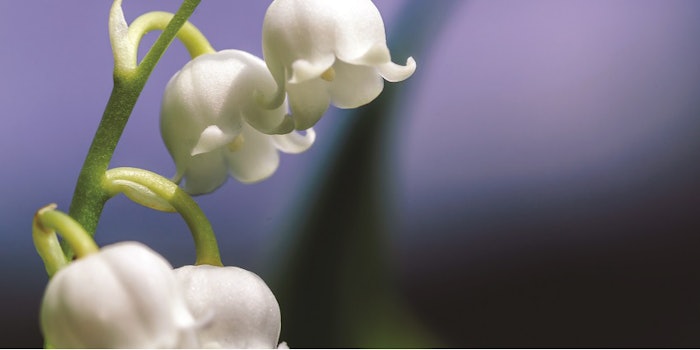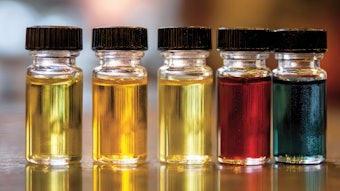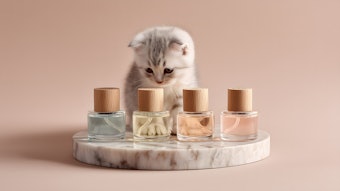
The lily of the valley flower, Convallaria Majalis (Liliaceae, also called muguet in France), has shown for many years a reluctance to reveal its uses in perfumery. Conventional extraction methods, such as distillation, solvent or supercritical carbon dioxide extraction have proved unable to isolate useful amounts of essential oil. Moreover, in contrast to other important members of the floral family such as rose, violet, jasmine or iris, which are all associated to a specific chemical family of molecules, the analysis of the lily of the valley flower did not reveal the existence of a signature ingredient. According to a study led at Dragoco (now Symrise)1 on the headspace of the flower, using GC-MS or GC-sniffing/GC-olfactometry techniques, the main identifiable constituents were benzyl alcohol (35 %), (Z)-3-hexen-1-ol (11 %), citronellol (9.6 %), geraniol (8.4 %) and (Z)-3-hexenyl acetate (7.8 %). Similar studies performed at Firmenicha also revealed trace amounts of phenylacetaldehyde oxime, which exhibits an interesting muguet-orange flower duality when in pure form. It was proposed that its combination with 2,3-laevo-dihydrofarnesol could reproduce the key note of the flower; however, the instability of this oxime prevents its use on industrial scale.2
Due to these difficulties in replicating a genuine muguet scent from natural materials, chemists played a key role in the task of recreating a muguet note from synthetic materials since the early 20th century. This resulted in the discovery of hydroxycitronellal, one of the very first synthetic ingredients not reproduced from nature, introduced almost simultaneously by Givaudan (as Laurine, 1906) and Firmenich (Cyclosiab, 1908). With its vertical character, associated with citral-like, green aspects, it has for decades constituted the base of lily of the valley accords and is still an important ingredient today. It exhibits a terpenic structure that resembles several of the natural muguet’s main components, but curiously, it has never been identified in it, nor in any other flower essential oil.
Hydroxycitronellal was later joined by a whole family of muguet aldehydes, whose main members, (Lilialc, Lyrald, Cyclosal, Heliopropanal, Bourgeonale) have become perfumery blockbusters. In addition to their floral scent, they have improved perfumery compositions spectacularly in numerous aspects, notably in terms of freshness, enhancement of naturalness, warmth and brilliance, and have thus become ubiquitous (see F-1). In particular, Lilial has a slightly sandalwood-like round body and a rosy, humid freshness that matches well with all types of floral bouquets. However, their aldehydic structure renders them unstable in strongly acidic or basic media; moreover, most of them are suspected to be of concern regarding human health, causing them to be in the forefront of the latest restrictions on perfumery materials. For example, all the aldehydes cited above, including hydroxycitronellal, are now being limited by IFRA and a strong decline in their use in the future can be anticipated, consequently rendering the discovery of more stable and innocuous replacers or substitutes crucial.
As all early synthetic muguet odorants were aldehydes (see F-2), this function has for long been suspected as being essential for the scent. In this context, the discovery of Mayolf by Firmenich in 1973 was a significant breakthrough.3 It is a simple alcohol that can be readily prepared by hydrogenation of cuminaldehyde and gained importance as a cheap, well-performing muguet ingredient. Its slight fatty side is counterbalanced by its ability in providing weight to floral-muguet accords. As an aside, the name Mayol has an interesting history: it is a tribute to the French café-concert singer Félix Mayol, who wore a bunch of lily of the valley flowers in his buttonhole on May 1st, 1895, before going on to sing on his first Parisian show! Following this discovery, Firmenich launched Florolg a few years later. It is another example of a cost-effective muguet alcohol, prepared in a single synthetic step. Unlike Mayol, Florol has a very clean facet and abundant volume, and can be used as a master key to carve muguet or floral accords as desired. Despite its terpenic structure that relates it to rose oxide, it has never been found in nature. Even today, Florol and Mayol are the two most commercially important muguet alcohols.
Recent years have met with increasing constraints in the use of traditional lily of the valley molecules, as a result of increasing suspicions regarding their safety.
The 1990s saw the discovery of two beautiful muguet ingredients. Discovered in 1994 by a talented Firmenich chemist, Béat Winter, a molecule later named Hivernalh (hiver meaning winter in French) shares a common dihydrocinnamic aldehyde scaffold with Lilial and several of its analogues;4 its olfactory character is however well differentiated, as it substitutes the fatty side of Lilial for a fresh, clean note that makes it reminiscent of freshly laundered linen. In the design of its industrial processes, Firmenich has put in practice the principles of green chemistry, as first formulated by Anastas and Warner.5 Within this regard, a new, expeditious synthesis of Hivernal was devised, wherein the two main sub-fragments are assembled in a single, catalytic step. Hereby, the number of intermediate derivatives used was minimized, while generating less waste and maximizing efficiency. The new quality of the product obtained was introduced in 2007 under the name of Hivernal Neo. Harry Frémont, master perfumer at Firmenich describes the uniqueness of Hivernal Neo as "the freshest and the longest lasting ingredient, although freshness and longlastingness normally do not coexist. Very monolithic and linear, its modifying power is unequaled with brightness and a humid facet.”
Discovered in 1996, also by Béat Winter, Lilyflorei was equally spectacular, having an unprecedented strength and performance for a muguet alcohol.6,7 It incorporates the main features of muguet aldehydes in addition to an excellent stability in application. Olfactively, it stands closer to hydroxycitronellal than Lilial. According to Firmenich perfumer Dora Baghriche, “Lilyflore, one of the most complete and equilibrated muguet molecules is addictive. Its slight lactonic facet makes it accessible, connected to other floral notes…” Another benefit is that Lilyflore is not on the list of IFRA restricted materials. A significant improvement in the key chemical transformation of the synthesis was recently implemented, resulting in a productivity increase of 330% with a concomitant reduction of a hazardous solvent, in accordance with the principles of green chemistry.22
Scent and Sustainability
Recent years have met with increasing constraints in the use of traditional lily of the valley molecules, as a result of increasing suspicions regarding their safety. Blockbusters like Lilial, Lyral or Bourgeonal have progressively been viewed with mistrust by several clients, leading to their restriction in some scented compositions. Given their ubiquity in all fields of perfumery, the reluctance to use these ingredients has led to a profound reconfiguration of the fragrance creation process, and a leading necessity for organic chemists to devise adequate replacements. Here, the close collaboration between chemists and perfumers, who identify business needs and play a key role in the selection process, proved to be a determining success factor. Also crucial is the coordination with the regulatory department, as the environmental and toxicological profile of new ingredients is decisive for their registration and their listing in chemical inventories. Towards this end, Firmenich has put in place an internal tool called “Green Gate” to evaluate the environmental impact of a molecule, and more specifically its biodegradability. This principle is applied systematically to all newly launched ingredients.
Under the strong leadership of master perfumer Pierre-Alain Blanc, Firmenich has found and introduced a set of new muguet compounds able to substitute ingredients like Lilial. In this connection, Tillenali was discovered8 and launched as a captive at Firmenich in 2013. Its scaffold, an hexahydro-cinnamic aldehyde derivative that is not prone to rearomatization, is novel in perfumery. It exhibits a fresh muguet odor reminiscent of linden blossoms, with an ozonic, fresh, melonal-like facet and a pine aspect that differentiate it clearly from the other members of the same family. Its high volatility renders it very useful as a top note; it can also be used as an exhauster of floral-muguet notes by its fresh, aldehydic facet. Firmenich is a pioneer in the reduction of esters by hydrogenation.9 This technology was successfully implemented in the production of Tillenal, having the advantage of using low amounts of solvent in mild and safe reaction conditions and accumulating very little waste. In comparison to previously used processes for the same type of reaction, this can be seen as a major achievement in green chemistry.
Josenolj, an aromatic allylic alcohol introduced in 2014, is nicely floral, with lilac and mimosa aspects, and an anisic side.10 It is comparable to Florol with more powdery, cosmetic aspects that provides it with additional complexity and velvetness. Towards the goal of bringing green chemistry to the forefront and applying sustainable technologies, Firmenich relied on its proprietary expertise in catalytic hydrogenation of aldehydes to design an industrial process with minimized waste and a lower E-factor. 11-13
Mimosalk was introduced in 2015.14 It is a tenacious lily of the valley aldehyde, yet greener than Lilial, with interesting aqueous, heliotropic facets. Its uniqueness is emphasized by François-Raphaël Balestra, perfumer and director new ingredients discovery at Firmenich: “Mimosal has an amazing duality combining a green freshness and a powdery softness so typical of mimosa flowers. To me it is like a cool floral wind in a velvet glove.” For a number of years, the development of an industrial process for this ingredient proved to be difficult and elusive. The solution finally arrived in the form of an unusual reduction of a dienal intermediate into the corresponding γ,δ-unsaturated aldehyde, using a catalytic system discovered and optimized at Firmenich.15 Finally, it is worth mentioning that Mimosal, as well as Tillenal and Josenol, all passed the Green Gate biodegradability criteria.
As a consequence of a 30-plus year research program devoted to the discovery of novel lily of the valley molecules, destined to complement both the current palette and to anticipate legislative changes, Firmenich is now equipped with a portfolio of original and performing muguet ingredients. Importantly, the molecules of the latest generation are biodegradable and exhibit an excellent environmental profile, which has allowed their regulatory department to register them worldwide. Their development, made in accordance with the principles of green chemistry, was notably motivated by the concern for maximizing efficiency and minimizing hazardous effects on human health and the environment. This approach falls within Firmenich’s global commitment to environmental management that has made it a recognized leader in sustainability. However, despite extensive efforts by all main F&F industry players, a perfect Lilial replacement, that would cumulate all its qualities in terms of versatility, performance and cost, still remains to be found.16-21 Its identification will be one of the major challenges of perfumery ingredients discovery in the coming years.

Julien Coulomb received his Ph.D. in organic chemistry in 2006 in Paris. After two post-doctoral periods (in Fargo, United States and Saclay, France), he joined the Firmenich R&D division in 2010 as a scientist. Since then, he has been devoted to the discovery of new perfumery ingredients with the aim of improving our current portfolio in terms of olfactive performance, safety, biodegradability and sustainability.











